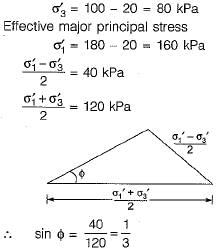Test: Shear Strength of Soil - 1 - Civil Engineering (CE) MCQ
10 Questions MCQ Test - Test: Shear Strength of Soil - 1
Which one of the following conditions is valid in case of unconfined compression test in comparison to tri-axial test?
Which one of the following is the appropriate tri-axial test to assess the immediate stability of an unloading prolfem, such as an excavation of a clay slope?
In a tri-axial test at failure, major principal stress was 180 kPa, minor principal stress was 100 kPa, and pore pressure was 20 kPa. The sine of the angle of shearing resistance of the sandy soil tested is
The relationship between a soil cohesion c and unconfined compressive strength qu is given as
In tri-axial compression test, the deviator stress is given by
In an unconfined compression test on a clay specimen of initial volume V and length L, the area of cross-section at failure is
The stresses responsible for mobilisation of shearing strength of soil is
In a direct shear test, the shear stress and normal stress on a dry sand sample at failure are 0.6 kg/cm2 and 1 kg/cm2 respectively. The angle of internal friction of the sand will be nearly:
Which of the following cannot be obtained by using un-drained test?









 is effective normal stress; for dry sand
is effective normal stress; for dry sand  = σ normal stress
= σ normal stress











